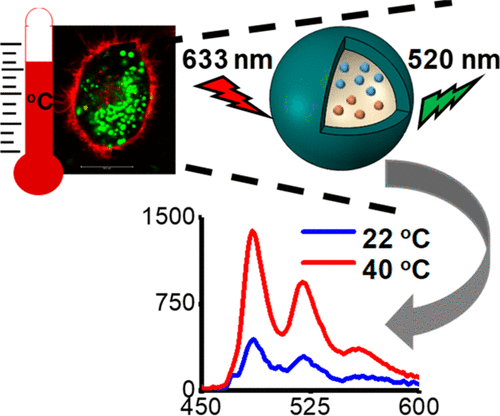当前位置:
X-MOL 学术
›
Biomacromolecules
›
论文详情
Our official English website, www.x-mol.net, welcomes your
feedback! (Note: you will need to create a separate account there.)
Temperature Sensing in Cells Using Polymeric Upconversion Nanocapsules.
Biomacromolecules ( IF 5.5 ) Pub Date : 2020-05-20 , DOI: 10.1021/acs.biomac.0c00377 Banu Iyisan 1 , Raweewan Thiramanas 1 , Nadzeya Nazarova 1 , Yuri Avlasevich 1 , Volker Mailänder 1, 2 , Stanislav Baluschev 1, 3 , Katharina Landfester 1
Biomacromolecules ( IF 5.5 ) Pub Date : 2020-05-20 , DOI: 10.1021/acs.biomac.0c00377 Banu Iyisan 1 , Raweewan Thiramanas 1 , Nadzeya Nazarova 1 , Yuri Avlasevich 1 , Volker Mailänder 1, 2 , Stanislav Baluschev 1, 3 , Katharina Landfester 1
Affiliation

|
Monitoring local temperature inside cells is crucial when interpreting biological activities as enhanced cellular metabolism leads to higher heat production and is commonly correlated with the presence of diseases such as cancer. In this study, we report on polymeric upconversion nanocapsules for potential use as local nanothermometers in cells by exploiting the temperature dependence of the triplet–triplet annihilation upconversion phenomenon. Nanocapsules synthesized by the miniemulsion solvent evaporation technique are composed of a polymer shell and a liquid core of rice bran oil, hosting triplet–triplet annihilation upconversion active dyes as sensitizer and emitter molecules. The sensitivity of the triplet–triplet annihilation upconversion to the local oxygen concentration was overcome by the oxygen reduction ability of the rice bran oil core. The triplet–triplet annihilation upconversion process could thus successfully be applied at different levels of oxygen presence including at ambient conditions. Using this method, the local temperature within a range of 22 to 40 °C could be determined when the upconversion nanocapsules were taken up by HeLa cells with good cellular viability. Thus, the higher cell temperatures where the cells show enhanced metabolic activity led to a significant increase in the delayed fluorescence spectrum of the upconversion nanocapsules. These findings are promising for further development of novel treatment and diagnostic tools in medicine.
中文翻译:

使用聚合物上转换纳米胶囊进行细胞温度传感。
在解释生物活动时,监测细胞内的局部温度至关重要,因为增强的细胞代谢会导致更高的热量产生,并且通常与癌症等疾病的存在相关。在这项研究中,我们通过利用三重态-三重态湮灭上转换现象的温度依赖性,报告了聚合物上转换纳米胶囊作为细胞中局部纳米温度计的潜在用途。采用细乳液溶剂蒸发技术合成的纳米胶囊由聚合物壳和米糠油液体核组成,内含三重态-三重态湮没上转换活性染料作为敏化剂和发射体分子。米糠油核的氧还原能力克服了三重态-三重态湮没上转换对局部氧浓度的敏感性。因此,三重态-三重态湮灭上转换过程可以成功地应用于不同的氧存在水平,包括环境条件。使用该方法,当上转换纳米胶囊被具有良好细胞活力的HeLa细胞吸收时,可以确定22至40°C范围内的局部温度。因此,细胞表现出增强的代谢活性的较高细胞温度导致上转换纳米胶囊的延迟荧光光谱显着增加。这些发现有望进一步开发新型医学治疗和诊断工具。
更新日期:2020-05-20
中文翻译:

使用聚合物上转换纳米胶囊进行细胞温度传感。
在解释生物活动时,监测细胞内的局部温度至关重要,因为增强的细胞代谢会导致更高的热量产生,并且通常与癌症等疾病的存在相关。在这项研究中,我们通过利用三重态-三重态湮灭上转换现象的温度依赖性,报告了聚合物上转换纳米胶囊作为细胞中局部纳米温度计的潜在用途。采用细乳液溶剂蒸发技术合成的纳米胶囊由聚合物壳和米糠油液体核组成,内含三重态-三重态湮没上转换活性染料作为敏化剂和发射体分子。米糠油核的氧还原能力克服了三重态-三重态湮没上转换对局部氧浓度的敏感性。因此,三重态-三重态湮灭上转换过程可以成功地应用于不同的氧存在水平,包括环境条件。使用该方法,当上转换纳米胶囊被具有良好细胞活力的HeLa细胞吸收时,可以确定22至40°C范围内的局部温度。因此,细胞表现出增强的代谢活性的较高细胞温度导致上转换纳米胶囊的延迟荧光光谱显着增加。这些发现有望进一步开发新型医学治疗和诊断工具。











































 京公网安备 11010802027423号
京公网安备 11010802027423号